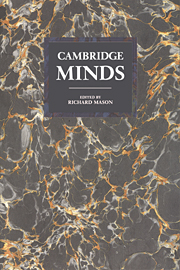Book contents
- Frontmatter
- Contents
- Notes on contributors
- Preface
- 1 The effects of a broken home: Bertrand Russell and Cambridge
- 2 I. A. Richards, F. R. Leavis and Cambridge English
- 3 Emily Davies, the Sidgwicks and the education of women in Cambridge
- 4 Radioastronomy in Cambridge
- 5 Three Cambridge prehistorians
- 6 John Maynard Keynes
- 7 Mathematics in Cambridge and beyond
- 8 James Stuart: engineering, philanthropy and radical politics
- 9 The Darwins in Cambridge
- 10 How the Burgess Shale came to Cambridge; and what happened
- 11 Ludwig Wittgenstein
- 12 ‘Brains in their fingertips’: physics at the Cavendish Laboratory 1880–1940
- 13 J. N. Figgis and the history of political thought in Cambridge
- 14 Molecular biology in Cambridge
- 15 James Frazer and Cambridge anthropology
- 16 Michael Oakeshott
5 - Three Cambridge prehistorians
Published online by Cambridge University Press: 21 October 2009
- Frontmatter
- Contents
- Notes on contributors
- Preface
- 1 The effects of a broken home: Bertrand Russell and Cambridge
- 2 I. A. Richards, F. R. Leavis and Cambridge English
- 3 Emily Davies, the Sidgwicks and the education of women in Cambridge
- 4 Radioastronomy in Cambridge
- 5 Three Cambridge prehistorians
- 6 John Maynard Keynes
- 7 Mathematics in Cambridge and beyond
- 8 James Stuart: engineering, philanthropy and radical politics
- 9 The Darwins in Cambridge
- 10 How the Burgess Shale came to Cambridge; and what happened
- 11 Ludwig Wittgenstein
- 12 ‘Brains in their fingertips’: physics at the Cavendish Laboratory 1880–1940
- 13 J. N. Figgis and the history of political thought in Cambridge
- 14 Molecular biology in Cambridge
- 15 James Frazer and Cambridge anthropology
- 16 Michael Oakeshott
Summary
My theme is the development of prehistory as a coherent discipline: a discipline in whose development Cambridge has played a significant role. Prehistory is generally defined as the study of the human past before the existence of written historical records (which first emerged in the Near East around 3000 bc). Such study relies almost exclusively upon the techniques of archaeology – the study of the human past using the material remains of human activity. Much of the story of the development and growth of prehistory as a discipline is thus bound up with the invention and application of new archaeological techniques, as well as new frameworks of interpretation. Only through such advances has the vast panorama of the human past been made available to us, and our own understanding of our place in the world and in the scheme of things been clearly established.
The Chair of Archaeology established in Cambridge by John Disney in 1851 was the first in Britain. It was instituted eight years before that other Cambridge graduate, Charles Darwin, with the publication of his On the Origin of Species, defined the context in which prehistoric archaeology would become established. It was not until 1927, however, that the Disney Chair became a full-time, teaching position: its sixth incumbent, Sir Ellis Minns, was a man of quiet erudition, whose Scythians and Greeks remains a standard work.
Already, with the first lectures in prehistoric archaeology, delivered in 1916 by Miles Burkitt, the subject had been systematically taught in Cambridge.
- Type
- Chapter
- Information
- Cambridge Minds , pp. 58 - 71Publisher: Cambridge University PressPrint publication year: 1994

